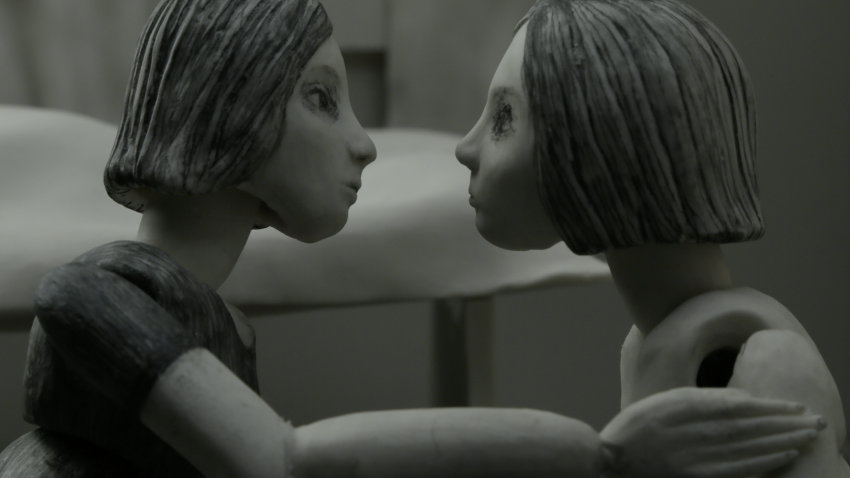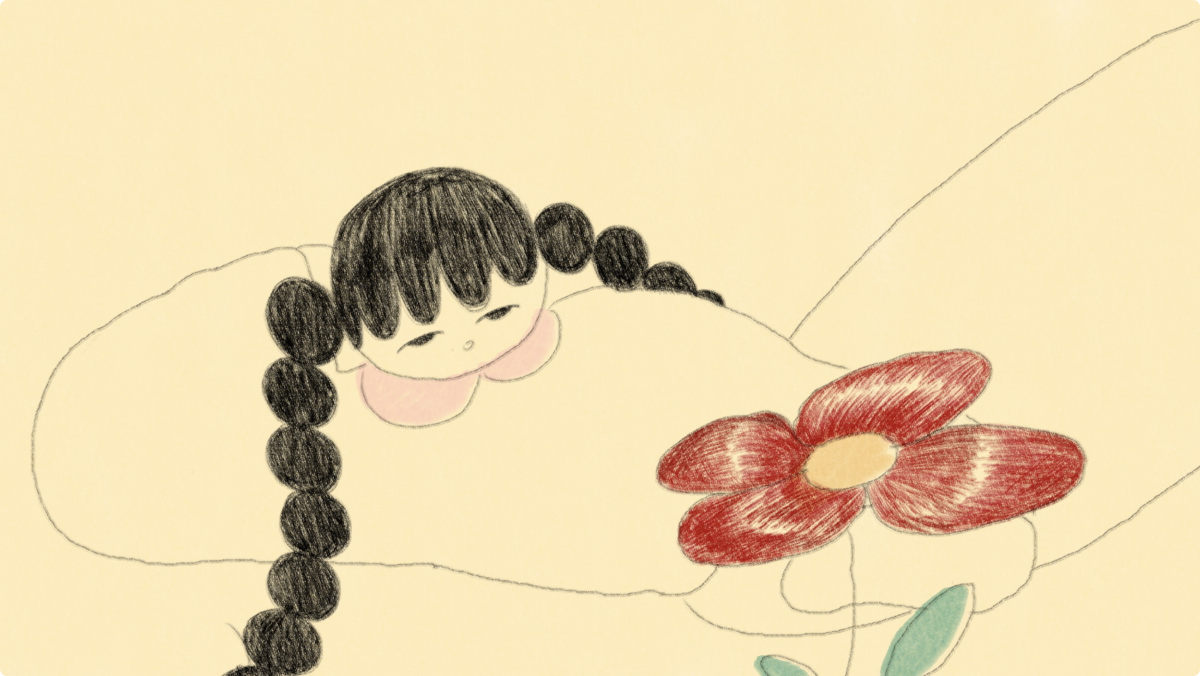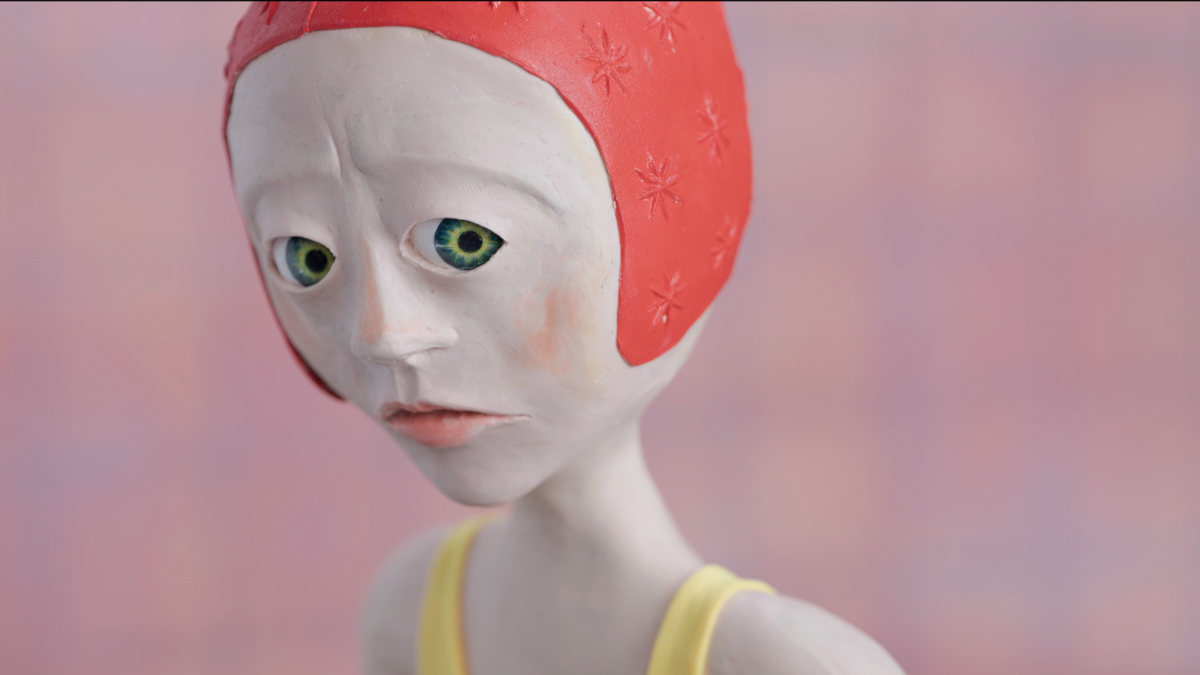Independent Animation Shorts
Body Echo by Ali Aschman

A woman discovers her own fractured self in the room next door. South African/US animation artist Ali Aschman (now based in London) constructs poetic narratives and psychological self-portraits in the form of drawing, sculpture, installation and animated short films.
And she does it well. In her latest animated short, Body Echo, which premieres online at Zippy Frames (and a Royal College of Art First Year Film), she expresses psychological fragility and fragmentation of identity.
ZF: The film looks personal, but it also touches gender issues. Would you have made this film five years ago, before the #Metoo movement?
AA: The concept for this film actually started as a reflection on heteronormative relationship structures, and included a third puppet that was male, and he repeatedly disassembled one of the women's body parts. It was going to be a plot-driven narrative film about the dynamics between these three characters, or rather, the male character and two manifestations of the female character. I ended up whittling the idea down to something much simpler and more introspective, and so I eliminated the third puppet completely, as it was the relationship between the two aspects of the woman that I found most interesting. So it's interesting to hear that you still read that subtext in the film.
It's hard to measure just how much the socio-political environment impacted the creation of this film - on the one hand, I've been making films about female doubles since 2013 when I made my very first animation, and the motif actually goes all the way back in my visual artwork to when I was a teenager; on the other hand, I have been addressing notions of gender more directly through my work in the last few years, specifically using bodily fragmentation as a way of speaking about objectification and identity, and the public conversations around such matters has certainly contributed to that. My previous short film, First Kiss, was a more explicit expression of my personal #MeToo-related experience.
I think my position as a woman in the world has always been, and will always be a factor in my creative output, even when I'm making work that is more abstract.
ZF: Your puppets have a porcelain feeling, like precious objects which break and need to put them back together again. So, how did you design the puppets here? Was it a natural transition from your artistic background as a sculptor?
AA: It was definitely a natural transition from my sculptural work. I like to merge different elements of my creative practice - so when I began working with ceramics a little over 4 years ago, I immediately started thinking about how I could use fired clay to make an animation, just as I had utilised my printmaking background in two cutout films, Elsewhere, the Survivors and The Wrong Story. So a couple of years ago I took a class at an art center in Chicago with sculptor Robin Power, to learn how to make articulated ceramic dolls. That was just before I moved to London to study at the Royal College of Art, and since I then had access to the RCA's ceramics studio, I decided that was the ideal moment to make a porcelain puppet film. I adore working with porcelain; I am fascinated by its simultaneous strength and fragility. It has a surface quality unlike any other material. To be honest, I didn't design the puppets very well, and really struggled to make them work! I was working on a very small scale which made the body parts difficult to wire together. In the end, they are far less animated than I originally intended, which meant I focused more on the film language and camera movements to express the mood and tell the story, rather than bodily gesture.
ZF: Tell me how you decided to differentiate one puppet from the other in terms of design and material? Was what we now see as two similar but also different puppets your first and only thought?
AA: I always intended for them to be identical, except one would be naked and one would be clothed. I tried to sculpt them as close to identical as possible, but since I wasn't using a mould and was sculpting by hand, they do have their slight differences. In the first draft of the narrative, the clothed puppet would leave the room and go out into the world, so she would have been more covered up, however in the final film she never goes outside so she ended up being semi-clothed.

There was also a plan to have the clothed one (the one that is assertive and active) have hairy legs, and to show the naked, passive one in the bath shaving her legs. I even sculpted a tiny razor from porcelain! Ultimately that scene got cut as the film transformed to be about internal conflict than about any interaction with the outside world, but I kept the hairy legs.
ZF: Narration proceeds like a poem, "In the room where you live". Is this your poem? Why did you decide to give to someone else to narrate?
AA: Yes, it is my poem/script, that I wrote alongside the process of animating. I have done the voice-over myself for several of my films, and I am bored of my films all sounding the same! Also, in my first term at the RCA, we did an exercise in which we each wrote a monologue and recorded a classmate reading it, and then made a quick film from found footage to accompany it. I really loved the way that Emily Downe read mine. Her voice has a fragility and poignancy that really resonated with my style, and so when it came to making Body Echo I immediately knew she would be the right choice. Another slightly silly reason is that so many RCA films use voice actors with British accents and I wanted to make a film within that tradition. My own hybrid South African/American accent just wasn't right for that!
ZF: How did you start working on the project? Designing the puppet, thinking about the idea, organizing your cinematic space. Which came first in Body Echo?
AA: The project started from a desire to make a puppet animation using porcelain, so it was materially-driven. I then thought about what sort of narrative and tone would make sense using a material with those qualities - delicate, monochrome, hard and cold. Constructing puppets from a rigid material, which meant exposed joints, also lent itself to deconstruction and fragmentation, and so that fed into the story.
ZF: How much help did you have in making the film? Music, sound design etc?
AA: I did all of the design, fabrication, lighting, animation and editing myself. The immensely talented composer Sarah Playford, who was at the Royal College of Music at the time, wrote the musical score. I recorded the foley sounds using pieces of porcelain, and scratching graphite on paper, but it was all brought together and filled out by sound designer Kevin Langhamer who was studying at the National Film and Television School. I've been very lucky to work with both Sarah and Kevin again this year on my graduation film Shadow Passage.
ZF: Would you have made Body Echo in an open space environment? Or in a closed environment, but not in a bedroom setting?
AA: The bedroom setting is integral to the film. I wanted an intimate, domestic space. The film is about isolation, depression and inner conflict, and although that can permeate all sorts of environments, I personally associate those feelings with being at home alone in my room. Additionally, with the time I had to make the film, and knowing that constructing the puppets and props from porcelain would be time-consuming, given that the clay has to dry out slowly and then be fired, I decided on a two-room duplicate environment. Anything beyond that would have been too much work.
ZF: If they gave you 200.000 GBP to make the film in vibrant colors, would you do it?
AA: Hahaha. No. But I'd take the money and make a different film!
Film Review:
Every film about fragmentation needs at least to be divided in appropriate narrative and aesthetic terms. Ali Aschman's film starts and ends by being duplicated (not exactly, still), while the middle part features a desperate effort to re-connect. Ceramic materials have the connotations of slickness and fragility; but here the implications seems to be the ones of heaviness; pieces of self have to be re-united, screeching sounds included. There's a lot of calculated agony in Ali Aschman's film, prominent in her camera movements (smooth panning to reveal the hidden door, a bird's eye view shot to increase the sense of helplessness between the two adjoining rooms). With an excellent sense of timing and a soundtrack that leaves no doubts on its sad outcome, Body Echo functions like an ancient elegy of sorts, a cry for something more than everyday experience. Unlike its main characters, a solid and inviting work.
Credits:
Script, Direction, Animation: Ali Aschman
Voice: Emily Downe
Music: Sarah Playford
Sound Design: Ali Aschman and Kevin Langhamer
Sound Mix: Kevin Langhamer
Ali Aschman Webpage










